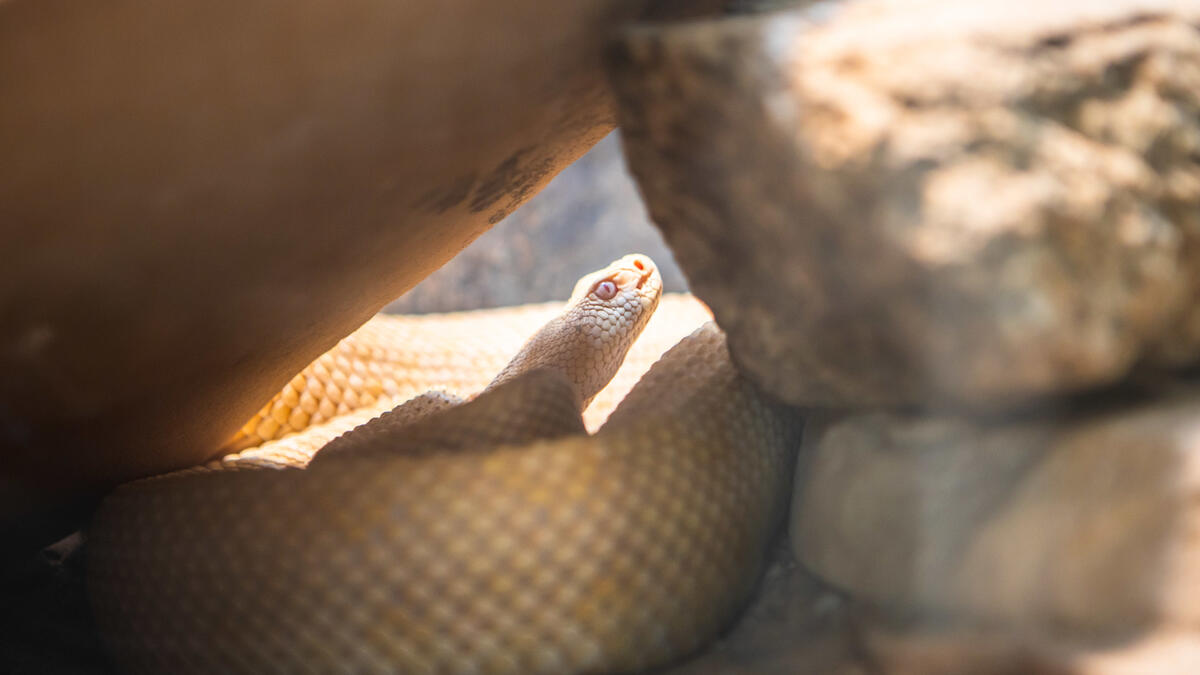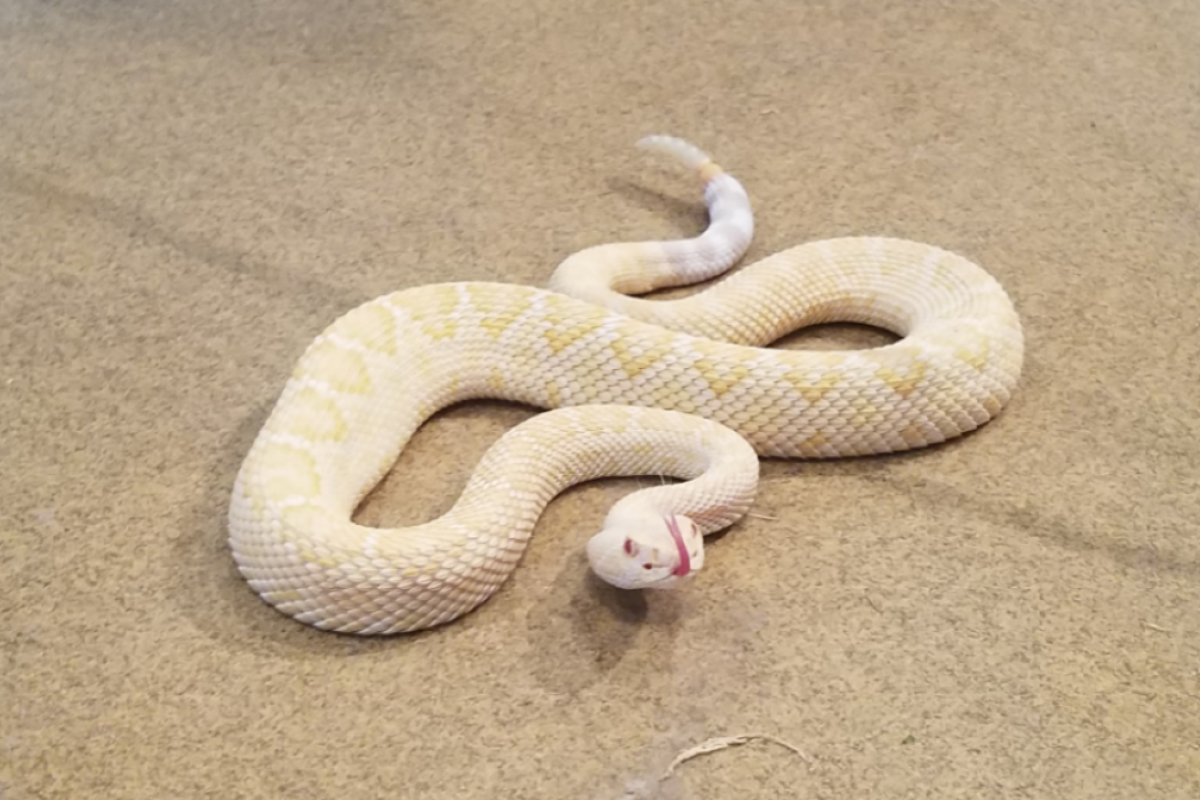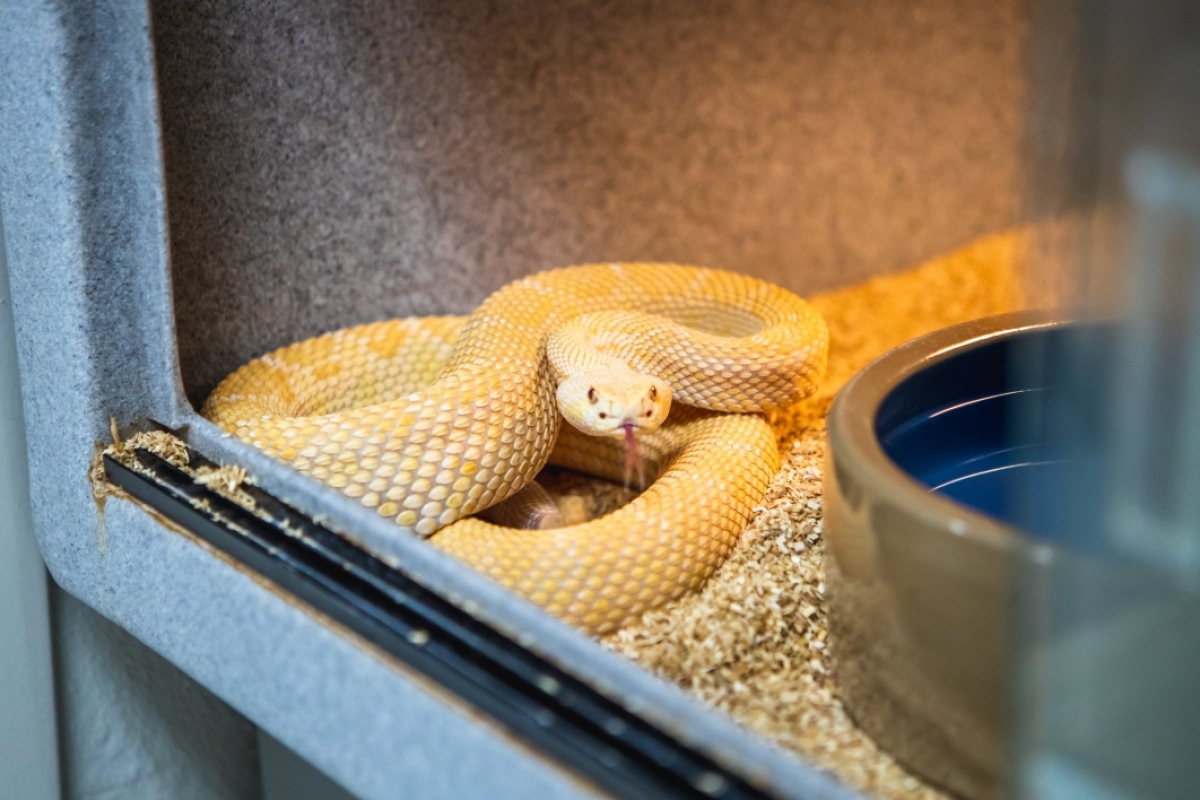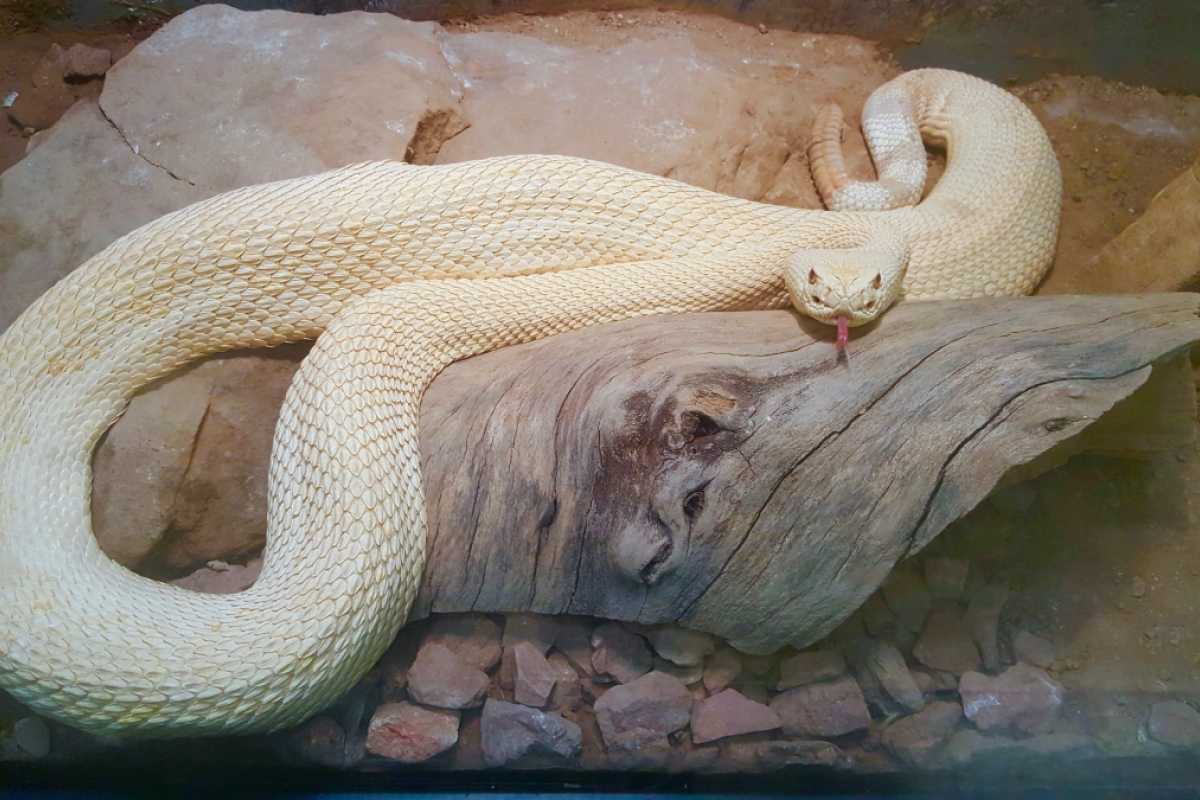The untold origin story of ASU's beloved late albino rattlesnake Hector

Hector, the beloved 25-year-old albino Western diamondback rattlesnake who had been at ASU's School of Life Sciences for more than two decades, had five offspring — including Joey, pictured here. Joey is still on display today in the Life Sciences Building A. Photo by Max Conacher/ASU
Editor’s note: This story is featured in the 2021 year in review.
In April 2019, Arizona State University said goodbye to Hector, the beloved 25-year-old albino Western diamondback rattlesnake who had been at the School of Life Sciences for more than two decades. Being a rare breed of snake, Hector had a far-reaching impact on the ASU community, even after his death.
But it wasn’t just the ASU community he had a long-lasting impact on. Now, the children of the man who rescued Hector from the wild are sharing an untold side of the beloved snake’s story.
In 1995, Bert Allen “B.A.” Naholowa’a was driving with his oldest daughter, Makalika, near where they lived in Tonopah, Arizona, when he spotted the albino snake slithering across the road.
“It stuck out to him because of the color,” Makalika said. “He didn’t think the snake was likely to survive in the wild, because its coloring in the desert is a disadvantage.”
B.A. pulled off to the side of the road and picked up the snake with his bare hands — which wasn’t a totally uncommon thing for him to do as he had adopted and handled snakes regularly.
He named the snake Hector and although his family can’t recall why he chose that particular name, they said for B.A. it made sense that all animals he encountered would have names. B.A. and his family are Native Hawaiians, and Native Hawaiian beliefs were reflected in how he perceived nature and animals.
“In traditional Western sciences, there’s no place for personification of animals or plants,” said Callie, B.A.’s second-oldest daughter. “Many parts of nature have names, spirits and personhood in Indigenous cultures. Naming something doesn’t make it any less of what it is, if anything it just makes you appreciate what it is more.”
In addition to his profound reverence for animals and nature, B.A. was also interested in the sciences. This led him to contact the Phoenix Zoo, in the hopes that the snake could receive safe harbor while serving as a source for learning and inspiration to the community. However, the zoo didn’t believe B.A. had a Western albino rattlesnake, as they are incredibly rare.
Because of the fees to visit animals at the zoo at the time, B.A. was concerned that he and his family might not be able to see the snake if it was in the zoo’s care. B.A. then contacted ASU, and after having a look at the snake, ASU faculty agreed to care for Hector and keep him on display for all to enjoy.
“Hector was on display for more than 20 years and during that time likely tens of thousands of students, both in grade school and college, saw him,” said Dale DeNardo, a professor in the School of Life Sciences and attending veterinarian and director of the Department of Animal Care and Technologies. “The impact of his presence and the legacy he left is exemplified by the comments I still get from people I meet away from campus about the large albino rattlesnake they saw on campus.”
Over the years, the School of Life Sciences lost contact with B.A. and his family. But earlier this year, after coming across the article announcing Hector’s passing, B.A.’s children reached out to ASU in the hopes of sharing their father’s story.
They were sad to hear of Hector’s passing, as they were also grieving the loss of B.A., who died in 2016, after having a heart attack while volunteering as a medic at the Dakota Access Pipeline protests on the Standing Rock Indian Reservation.
B.A. had five children — Makalika, Callie, Howard, Reuben and Angelique. His daughters all attended ASU and often visited Hector where he was on display in the Life Sciences Building A. Over the years they also brought their own children to see Hector.
Coincidentally, Hector also had five offspring of his own — he was bred several times when faculty realized the importance of carrying on the genes of the only captive albino Western diamondback snake in Arizona.
Hector’s legacy of education and enrichment lives on in 2021. One of Hector’s male offspring is still on display in the Life Sciences Building with his mother, with an additional female offspring also kept at ASU off exhibit. Another male offspring is cared for at the Phoenix Zoo. In addition there was a single offspring born at ASU in 2019, a grandchild of Hector, who will likely be adopted out to another institution.
After discovering the scope of Hector’s impact on the ASU community, the Naholowa’a family said they are full of pride, and they're sure their father would be too.
“It's such a big deal to all of us and we are super proud of our dad. Hector was so beautiful, I know our dad took major pride in being a part of his life,” B.A.’s son Howard said. “Nobody else would have picked up that snake and made the effort to get him protection. Our family has come a long way, but we had no money and very little resources at that time. It was a major effort to contact the zoo and ASU, and then make the 60-mile journey to deliver him.
"I'm really happy that so many people were able to see the snake. I never realized how big of an impact he had on the people walking through that hallway until I read the ASU article.”
B.A.’s children believe that including his part in Hector’s story is important, and that bringing the Indigenous worldview their father had to science, technology, engineering and mathematics (STEM) can positively change our understanding of Indigeneity and science.
“Too often Indigenous characters are left out of real-life stories about science, so we really appreciate the chance to share the part that my dad played in Hector’s life. I think a lot of times the media portrays Indigeneity as being spiritual and not scientific, and that is not correct,” Makalika said. “Indigenous spirituality is fundamentally based upon observation, which is what Western science is based off of … It is so important to recognize the role of Indigenous contributions to our lived experiences in the sciences. Understanding that we are a part of that story gives an accurate depiction of the system and makes space to help bridge these gaps between Indigenous worlds and the Western world.”
Above all else, they hope their father’s story inspires others to respect animals and view them as one with humans.
“Understanding the wonder of nature and the wonder of the animal kingdom is so powerful,” Callie said. “If we view animals as people, and we start treating them with the respect that people are due, then it's not only good for the animals, it's actually good for us, because it makes us better human people. What I would love to see happen as Indigenous people are included in these conversations is that institutions are actually empowering everybody to be better humans.”
More Science and technology

ASU-led space telescope is ready to fly
The Star Planet Activity Research CubeSat, or SPARCS, a small space telescope that will monitor the flares and sunspot activity…

ASU at the heart of the state's revitalized microelectronics industry
A stronger local economy, more reliable technology, and a future where our computers and devices do the impossible: that’s the…

Breakthrough copper alloy achieves unprecedented high-temperature performance
A team of researchers from Arizona State University, the U.S. Army Research Laboratory, Lehigh University and Louisiana State…






